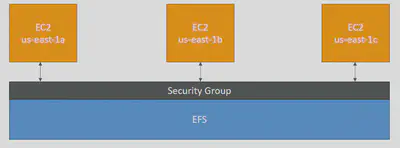Storage Options in AWS
EBS
An EBS (Elastic Block Store) Volume is a network drive (i.e. not a physical drive) you can attach to your instances while they run. Well suited for use as the primary storage for file systems, databases or for any applications that require fine granular updates and access to raw, unformatted block level storage. It allows your instances to persist data.
- An EC2 machine loses its root volume (main drive) when it is manually terminated.
- Unexpected terminations might happen from time to time (AWS would email you)
- Sometimes, you need a way to store your instance data somewhere
- An EBS (Elastic Block Store) Volume is a network drive you can attach to your instances while they run
- It allows your instances to persist data
Features
It’s a network drive (i.e. not a physical drive)
- It uses the network to communicate the instance, which means there might be a bit of latency
- It can be detached from an EC2 instance and attached to another one quickly
It’s locked to an Availability Zone (AZ)
- An EBS Volume in us-east-1a cannot be attached to us-east-1b
- To move a volume across, you first need to snapshot it
Have a provisioned capacity (size in GBs, and IOPS)
- You get billed for all the provisioned capacity
- You can increase the capacity of the drive over time
Types of EBS volumes
GP2: General Purpose Volumes (cheap)
- Recommended for most workloads like System boot volumes, Virtual desktops, Low-latency interactive apps, Development and test environments
- 3 IOPS / GiB, minimum 100 IOPS, burst to 3000 IOPS, max 16000 IOPS
- 1 GiB – 16 TiB , +1 TB = +3000 IOPS
IO1: Provisioned IOPS (expensive)
- Critical business applications that require sustained IOPS performance, or more than 16,000 IOPS per volume (gp2 limit)
- Large database workloads, such as: MongoDB, Cassandra, Microsoft SQL Server, MySQL, PostgreSQL, Oracle
- Min 100 IOPS, Max 64000 IOPS (Nitro) or 32000 (other)
- 4 GiB - 16 TiB.
- The maximum ratio of provisioned IOPS to requested volume size (in GiB) is 50:1
ST1: Throughput Optimized HDD
- Streaming workloads requiring consistent, fast throughput at a low price like Big data, Data warehouses, Log processing, Apache Kafka
- Cannot be a boot volume
- 500 GiB – 16 TiB , 500 MiB /s throughput
SC1: Cold HDD, Infrequently accessed data
- Throughput-oriented storage for large volumes of data that is infrequently accessed. Scenarios where the lowest storage cost is important.
- Cannot be a boot volume
- 500 GiB – 16 TiB , 250 MiB /s throughput
InstanceStore
Some instance do not come with Root EBS volumes, instead, they come with “Instance Store” (= ephemeral storage) Instance store is physically attached to the machine (EBS is a network drive)
Pros:
- Very High IOPS (in millions because it’s physical)
- Disks up to 7.5 TiB (can change over time), stripped to reach 30 TiB (can change over time…)
- Better I/O performance (EBS gp2 has an max IOPS of 16000, io1 of 64000)
- Good for buffer / cache / scratch data / temporary content
- Data survives reboots
Cons:
- On stop or termination, the instance store is lost
- You can’t resize the instance store
- Backups must be operated by the user
EFS
Amazon Elastic File System (EFS) is a scalable cloud file storage solution for use with EC2 instances. It’s elastic because it will automatically grow and shrink as you add/remove files and is priced with pay per use model. It’s similar to EBS, but with EBS you can only mount your virtual disk to one EC2 instance. You can have multiple instances sharing an EFS volume in multiple AZs. Uses security group to control access to EFS.

Features
Use cases: content management, web serving, data sharing, Wordpress
Uses NFSv4.1 protocol
Uses security group to control access to EFS
Compatible with Linux based AMI (not Windows)
Encryption at rest using KMS
POSIX file system (~Linux) that has a standard file API
File system scales automatically, pay-per-use, no capacity planning!
EFS Scale
- 1000s of concurrent NFS clients, 10 GB+ /s throughput
- Grow to Petabyte-scale network file system, automatically
Performance mode (set at EFS creation time)
- General purpose (default): latency-sensitive use cases (web server, CMS, etc…)
- Max I/O – higher latency, throughput, highly parallel (big data, media processing)
Storage Tiers (lifecycle management feature – move file after N days)
- Standard: for frequently accessed files
- Infrequent access (EFS-IA): cost to retrieve files, lower price to store
Comparison
EBS

- Can be attached to only one instance at a time. They are locked at the Availability Zone (AZ) level
- EBS is a network drive.
- EBS gp2 has an max IOPS of 16000, io1 of 64000
- To migrate an EBS volume across AZ
- Take a snapshot
- Restore the snapshot to another AZ
- EBS backups use IO and you shouldn’t run them while your application is handling a lot of traffic
- Root EBS Volumes of instances get terminated by default if the EC2 instance gets terminated.(you can disable that)
EFS

- EFS is a network drive
- Mounting 100s of instances across AZ
- EFS share website files (WordPress)
- Only for Linux Instances (POSIX)
- EFS has a higher price point than EBS
- Can leverage EFS-IA for cost savings
InstanceStore
- Instance store is physically attached to the machine
- Better I/O performance (in millions)
- On stop or termination, the data in instance store is lost
- The InstanceStore size is determined by the Instance type. You can’t resize the instance store.
- Backups must be operated by the user